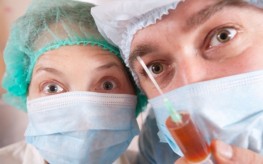 Sean Adl-Tabatabai – Scientists have detected deadly microplastics in human blood for the first time, leaving them baffled and concerned about what is causing the mysterious outbreak.
Sean Adl-Tabatabai – Scientists have detected deadly microplastics in human blood for the first time, leaving them baffled and concerned about what is causing the mysterious outbreak.
According to researchers, the tiny particles were found in a whopping 80% of people tested.
The discovery shows the deadly particles can travel around the body and may lodge in organs, leading to death. Researchers are concerned as microplastics cause damage to human cells in the laboratory and air pollution particles are already known to enter the body and cause millions of early deaths every year.
Theguardian.com reports: The scientists analyzed blood samples from 22 anonymous donors, all healthy adults and found plastic particles in 17.
“Our study is the first indication that we have polymer particles in our blood – it’s a breakthrough result,” said Prof Dick Vethaak, an ecotoxicologist at Vrije Universiteit Amsterdam in the Netherlands. “But we have to extend the research and increase the sample sizes, the number of polymers assessed, etc.” Further studies by a number of groups are already under way, he said.
“It is certainly reasonable to be concerned,” Vethaak told the Guardian. “The particles are there and are transported throughout the body.” He said previous work had shown that microplastics were 10 times higher in the faeces of babies compared with adults and that babies fed with plastic bottles are swallowing millions of microplastic particles a day.
“We also know in general that babies and young children are more vulnerable to chemical and particle exposure,” he said. “That worries me a lot.”
The new research is published in the journal Environment International and adapted existing techniques to detect and analyze particles as small as 0.0007mm. Some of the blood samples contained two or three types of plastic. The team used steel syringe needles and glass tubes to avoid contamination, and tested for background levels of microplastics using blank samples.
Vethaak acknowledged that the amount and type of plastic varied considerably between the blood samples. “But this is a pioneering study,” he said, with more work now needed. He said the differences might reflect short-term exposure before the blood samples were taken, such as drinking from a plastic-lined coffee cup, or wearing a plastic face mask.
“The big question is what is happening in our body?” Vethaak said. “Are the particles retained in the body? Are they transported to certain organs, such as getting past the blood-brain barrier?” And are these levels sufficiently high to trigger disease? We urgently need to fund further research so we can find out.”
The new research was funded by the Dutch National Organisation for Health Research and Development and Common Seas, a social enterprise working to reduce plastic pollution.
SF Source News Punch Mar 2022
